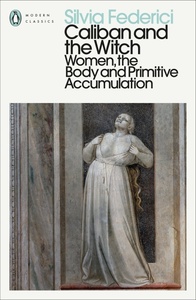Take a photo of a barcode or cover
challenging
informative
inspiring
reflective
slow-paced
Despite being a necessary intervention in a Marxist history of the transition from feudalism to capitalism, there are some glaring vacancies in Federici's accounting. Homosexuality & queerness is referenced hardly at all, and the gender-essentialism is rather loud (there are only men and women in Federici's history of gender & sexuality under the emergence of capitalism). The uses of studies of witchcraft and its persecution in Latin America feel out of place as well, as Federici imposes her view of a binary gender on the cases she cites, as well as using only Mexico & Peru to stand in for all of Latin America (she also says Mexico is in South America twice...). Rather than trace a global history of witchcraft, or even a comparative history of witchcraft during the age of colonialism in the Americas, Federici seems to use Latin American samples as a way to continue a Eurocentric discussion of witchcraft.
In the end, an interesting and necessary feminist intervention in Marxist history, but there has got to be better material out there for readers in 2023 and beyond...
In the end, an interesting and necessary feminist intervention in Marxist history, but there has got to be better material out there for readers in 2023 and beyond...
This is one of the most important books I’ve read. A tight survey of the history of misogyny and evil capital. I learned innumerable lessons from this text, and have a better understanding of our cultural foundations.
i thought this was really good and interesting, although it definitely has the standard set of 'theory problems' - primary source work is quite thin on the ground, some fairly sweeping statements are not followed up - which annoy me more with every book i read. also, it feels somewhat incomplete? it just kind of stops
“With the marginalization of the midwife, the process began by which women lost the control they had exercised over procreation, and were reduced to a passive role in child delivery, while male doctors came to be seen as the true “givers of life” (as in the alchemical dreams of the Renaissance magicians). With this shift, a new medical practice also prevailed, one that in the case of a medical emergency prioritized the life of the fetus over that of the mother. This was in contrast to the customary birthing process which women had controlled; and indeed, for it to happen, the community of women that had gathered around the bed of the future mother had to be first expelled from the delivery room, and midwives had to be placed under the surveillance of the doctor, or had to be recruited to police women” (Federici 89).
When I think of witch hunts, the thing that immediate comes to mind is religious hysteria. I was born in the '80s, so I never really experienced all the renewed commotion about cults and satanic rituals that reemerged in the Reagan years. At best, I framed the entire idea through an arrogant atheist lens, taking the Salem witch trials for instance as further evidence of the irrationality that undergirded the religious experience that I so despised growing up.
Silvia Federici's work in Caliban and the Witch reframes and recontextualises the original witch hunts in Europe by looking more closely at the origins of the practice, who they actually affected and what the practical effect of it all was.
The headline argument is that the witch hunt was a practical tool used to break the back of the peasantry in the transition from the feudal system of primitive accumulation to capitalism. She argues that the transition as it happened was not inevitable, but required winning a war against the peasants who resisted the enclosure of the commons.
Where in the system of feudalism, women's contribution to a subsistence economy put them on more or less equal footing with men, a wage-based system began a shift in the perception of "women's work" that essentially removed their labor from the moneyed economy.
"In the transition from feudalism, the working class more generally was separated from the land, removing their ability to subsist outside a moneyed economy. Women become a collective replacement for the commons, their labor removed from the formal economy. And that was cemented by changes to the family that functionally criminalized independent women while making them dependent on the family."
Since women -- particularly older women -- stood to lose the most from this transition, they were often at the head of the movements resisting the enclosures. As the itinerate healers, herbalists and keepers of the lore, they were also in many ways the cultural focal points of feudal communities. They also retained stores of knowledge that helped control reproduction for feudal women -- with herbal forms of sterilization, birth control and abortion as well as a role as midwives.
So when you then consider a lot of the iconography of the witch, you can see all the ways that their contributions to their communities were warped and turned into Satanic imagery. Worship of pagan gods become worship of the Devil. Revolutionary meetings in the woods at night (plus some polygamy!) become Satanic orgies. Herbalism becomes a disposition to poisoning. Abortion becomes the ritual sacrifice and consumption of babies.
Even with the loss of the peasant resistance and the ultimate victory of capitalism, you see how the witch is just used to beat down and level off any woman who dares resist the patriarchal status quo.
"Just as the Enclosures expropriated the peasantry from the communal land, so the witch-hunt expropriated women from their bodies, which were thus 'liberated' from any impediment preventing them to function as machines for the production of labor. For the threat of the stake erected more formidable barriers around women's bodies than were ever erected by the fencing of the commons."
This is a model that Federici notes continues unabated even today, as global capitalism continues to enforce "enclosures" in as-yet-untapped regions like sub-Saharan Africa.
"[T]he political lesson that we can learn... is that capitalism, as a social-economic system, is necessarily committed to racism and sexism. For capitalism must justify and mystify the contradictions built into its social relations -- the promise of freedom vs. the reality of widespread coercion, and the promise of prosperity vs. the reality of widespread penury - by denigrating the 'nature' of those it exploits."
It's amazing how it takes Federici only 200 pages to totally change my perspective of the persecution of witchcraft into a really potent critique of the essential patriarchal nature of capitalism. To be sure, once the witch hunts are unleashed, they still take on a hysterical religious character, but it's a lot easier to see what their effect is as a tool of social control.
This was a great read. One I am glad I bought and that I am almost certain to return to again.
Silvia Federici's work in Caliban and the Witch reframes and recontextualises the original witch hunts in Europe by looking more closely at the origins of the practice, who they actually affected and what the practical effect of it all was.
The headline argument is that the witch hunt was a practical tool used to break the back of the peasantry in the transition from the feudal system of primitive accumulation to capitalism. She argues that the transition as it happened was not inevitable, but required winning a war against the peasants who resisted the enclosure of the commons.
Where in the system of feudalism, women's contribution to a subsistence economy put them on more or less equal footing with men, a wage-based system began a shift in the perception of "women's work" that essentially removed their labor from the moneyed economy.
"In the transition from feudalism, the working class more generally was separated from the land, removing their ability to subsist outside a moneyed economy. Women become a collective replacement for the commons, their labor removed from the formal economy. And that was cemented by changes to the family that functionally criminalized independent women while making them dependent on the family."
Since women -- particularly older women -- stood to lose the most from this transition, they were often at the head of the movements resisting the enclosures. As the itinerate healers, herbalists and keepers of the lore, they were also in many ways the cultural focal points of feudal communities. They also retained stores of knowledge that helped control reproduction for feudal women -- with herbal forms of sterilization, birth control and abortion as well as a role as midwives.
So when you then consider a lot of the iconography of the witch, you can see all the ways that their contributions to their communities were warped and turned into Satanic imagery. Worship of pagan gods become worship of the Devil. Revolutionary meetings in the woods at night (plus some polygamy!) become Satanic orgies. Herbalism becomes a disposition to poisoning. Abortion becomes the ritual sacrifice and consumption of babies.
Even with the loss of the peasant resistance and the ultimate victory of capitalism, you see how the witch is just used to beat down and level off any woman who dares resist the patriarchal status quo.
"Just as the Enclosures expropriated the peasantry from the communal land, so the witch-hunt expropriated women from their bodies, which were thus 'liberated' from any impediment preventing them to function as machines for the production of labor. For the threat of the stake erected more formidable barriers around women's bodies than were ever erected by the fencing of the commons."
This is a model that Federici notes continues unabated even today, as global capitalism continues to enforce "enclosures" in as-yet-untapped regions like sub-Saharan Africa.
"[T]he political lesson that we can learn... is that capitalism, as a social-economic system, is necessarily committed to racism and sexism. For capitalism must justify and mystify the contradictions built into its social relations -- the promise of freedom vs. the reality of widespread coercion, and the promise of prosperity vs. the reality of widespread penury - by denigrating the 'nature' of those it exploits."
It's amazing how it takes Federici only 200 pages to totally change my perspective of the persecution of witchcraft into a really potent critique of the essential patriarchal nature of capitalism. To be sure, once the witch hunts are unleashed, they still take on a hysterical religious character, but it's a lot easier to see what their effect is as a tool of social control.
This was a great read. One I am glad I bought and that I am almost certain to return to again.
Federici's Caliban and The Witch is a Classic Works of Marxist Feminism in which she explores the concept of primitive accumulation and the formation of the body politic. This book gets recommended a lot, and so if you enjoyed this book I would read the smaller books of essays that Federici has put out of the past few years where she expands on these ideas
challenging
informative
slow-paced
informative
reflective
medium-paced
Brilliantly researched, presented and written. EVERYONE SHOULD READ THIS!!
challenging
informative
reflective
slow-paced





